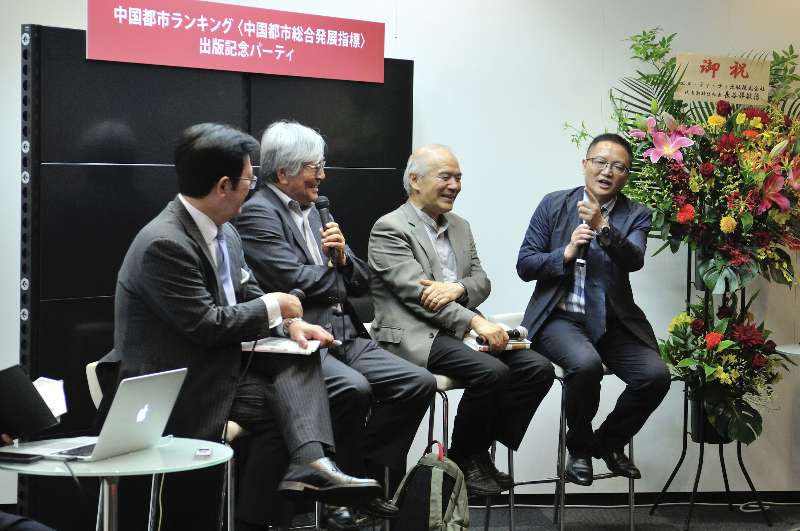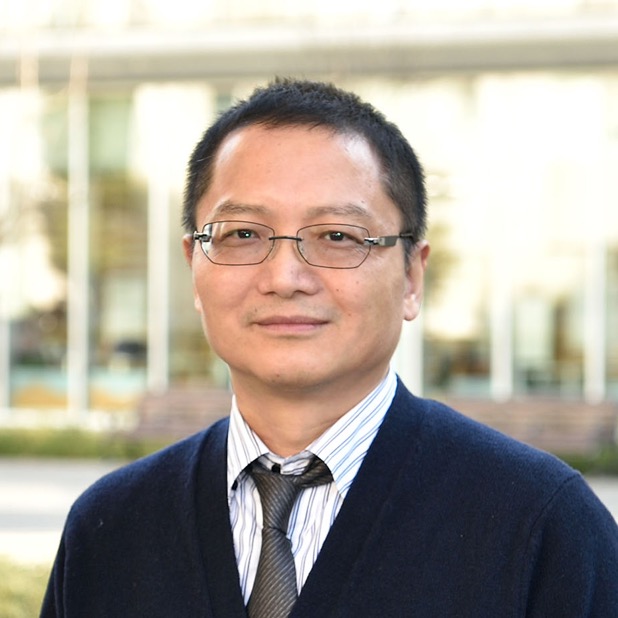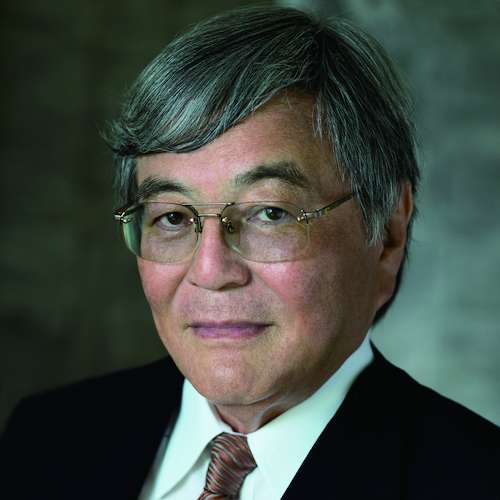


Editor’s note: The COVID-19 pandemic has dealt a heavy blow to big cities like New York, London and Tokyo, drawing wide concern over the outlook of international metropolises. How to balance urban development and ecological protection? How to lead a city’s cultural development? Join Professor Zhou Muzhi and Professor Yoshinori Yokoyama as they brainstorm what those big cities have in store.
Introduction of speakers:

Zhou Muzhi
President of Cloud River Urban Research Institute and professor of Tokyo Keizai University. Ph.D. in Economics.
Experience: Visiting researcher of Harvard University, visiting professor of Massachusetts Institute of Technology, visiting professor of the Chinese Academy of Sciences, and visiting researcher of the Policy Research Institute, Japanese Ministry of Finance. Also guest research fellow of Japan Environmental Sanitation Center, and independent director of MTI Co., Ltd.

Yoshinori Yokoyama
Adviser of the Office of the President, the University of Tokyo, and former director of McKinsey & Company, Inc. Tokyo Office.
Experience: Senior fellow of the Research Institute of Economy, Trade, and Industry, auditor and member of management committee of Industry Reconstruction Corporation of Japan, guest professor of Hitotsubashi University graduate school, professor of the University of Tokyo, member of the National Diet of Japan Fukushima Nuclear Accident Independent Investigation Commission, council member of Japan Agency for Medical Research and Development. Also independent director of Sumitomo Mitsui Financial Group, independent director of Sumitomo Mitsui Banking Corporation, and independent director of ORIX Life Insurance Corporation.
Globalization grows in tandem with urbanization
Zhou Muzhi: Cities originated from fairs and thrived on trade and exchanges. In 1950, only two megacities, Tokyo and New York, had a population over 10 million. By 1970, the Osaka megalopolis had been added to the list. However, the number of megacities has grown from five in 1980 to 33 today. They are mostly hubs for international exchanges that determine the future of world politics and economic development. With a combined population of 570 million, those megacities account for 15.7% of the world’s population of Urban Agglomerations. It is quite worthwhile for us to take a closer look at what’s behind their rapid growth.
Yoshinori Yokoyama: First of all, infrastructures are very important for urban development. Edo, what Tokyo was known as in the Tokugawa period, was built on marshes that had an ample supply of water, a very good drainage system and a sound network of canals for the transportation of goods and people. These infrastructures supported the development of Edo that had a population over 1 million.
Zhou Muzhi: The spring water in Inokashira Park near my home is the source of Kanda River. Tokugawa Ieyasu had indeed put a lot of efforts in finding quality water and building a network of waterways in Edo.
Yoshinori Yokoyama: The most important infrastructure that supports the development of modern Tokyo is the railway system, especially the Yamanote Line. Although the loop line did not adopt new technologies in its construction, it was a successful practice in the world’s urban planning history which widened the central business district (CBD) by creating several activity centers or CBDs like Marunouchi, Shinjuku, Shibuya and Ikebukuro. Compared with most US cities which have only one business district,. Those CBDs are modal change point between Yamanote Line loop and commuter rails. This transportation network increased the diversity of Tokyo’s urban life. Multiple CBDs in Tokyo have not only increased the city’s capacity, but also its diversity.
Zhou Muzhi: The railway system in Tokyo also contributes to the urban density.
Yoshinori Yokoyama: Yes. Los Angeles also has a downtown area, but the density of its urban facilities is low as people's movement mostly relies on automobiles. The beauty of Yamanote Loop is its adequate size. It takes one hour to go around. That means it takes less than 30 minutes to move from one point to another, which is psychologically acceptable. In this regard, London Loop is too big and Chicago Loop is too small.
Zhou Muzhi: Improving infrastructures and urban capacity are very important solutions for urban diseases. When the population was around 10 to 20 million, the Tokyo megalopolis already suffered from many problems. But as the population grows to 38 million today, many of the problems have been solved thanks to the city’s investment in high quality infrastructures. The ongoing COVID-19 pandemic is bound to stimulate investment in healthcare, drainage system, waste treatment and other public health infrastructures.
Of course, the capacity here does not indicate the actual living space but the ability to attract talents and create employment. After the 1980s, globalization and development of megacities are mainly driven by the global supply chain in manufacturing as well as the information technology (IT) revolution. It is fair to say that globalization has been growing in tandem with urbanization.
The 33 megacities in the world are either coastal cities or national capitals. The manufacturing industry in the global supply chain era depends very much on deepwater ports. So it is not surprising that the top 10 cities (Shenzhen, Shanghai, Dongguan, Suzhou, Foshan, Guangzhou, Ningbo, Tianjin, Hangzhou and Xiamen) in China’s 2018 manufacturing radiation ranking released by the Cloud River Urban Research Institute are all large container ports. They account for around half of the total volume of China’s export in goods.
Yoshinori Yokoyama: Japan’s export-oriented manufacturing industry is also highly concentrated in Tokyo, Osaka and Nagoya megalopolises. Those cities have good ports facing the Pacific Ocean because they have been the destination of cargos. Recently, the northern part of Kyushu facing the East China sea has thrived because of the increasing importance of China and intra-Asia trade.
Zhou Muzhi: Compared with manufacturing, the IT industry is more concentrated and converged in big cities and megacities.
As a typical part of the interaction economy, the IT industry needs to grow in an open, inclusive and diversified cultural environment, which coincides with the vibes of most coastal and central cities. Therefore, the top 10 cities in China’s 2018 ranking for IT radiation are Beijing, Shanghai, Shenzhen, Chengdu, Hangzhou, Nanjing, Guangzhou, Fuzhou, Ji’nan and Xi’an, which are either major big cities or coastal ones. The employment in IT, the number of IT companies listed on the main board, the SME board, and the second board in those 10 cities account for 53%, 76%, 60% and 81% of the country’s total, respectively.
Yoshinori Yokoyama: The IT industry in the United States first concentrated along Route 128 (Boston’s technology corridor) getting the benefit of intellectual properties of Harvard and MIT, then in Silicon Valley, which is close to Stanford and Fairchild Camera, Seattle with Microsoft, then, spread to other international metropolises like New York City.
Zhou Muzhi: Japan’s IT industry is highly concentrated in Tokyo megalopolis, which boasts 80% of the IT companies listed on the First Section Market of the Tokyo Stock Exchange.
There is an interesting relationship between manufacturing and IT radiation and urban functions. For example, from the perspective of transportation, manufacturing depends very much on the convenience of container ports, while the IT industry hinges much on airport convenience. Manufacturing radiation has a very high correlation with science & technology radiation and finance radiation, so does IT radiation with catering and hotel radiation as well as culture, sports, and entertainment radiation. What’s also noteworthy is that manufacturing radiation has relatively low correlations with healthcare radiation and higher education radiation, while IT radiation has high correlations with them. This means that people working in the IT industry have higher demands for catering, hotel, culture, entertainment, higher education and healthcare. Big cities with superior facilities in the above areas are more attractive to those talented professionals.
Yoshinori Yokoyama: IT sector is becoming more software intensive. This implies highly talented people are the source of value added. So a city’s amenity and comfort for them and their families is very important. Last year, I contributed an expert’s review to the 2018 China Integrated City Index highlighting a city’s provision for a comfortable life.
‘Satoyama’ style in urban development
Zhou Muzhi: There is always an impulse among the intellectuals to escape the city. As early as 35 years ago, the American futurist Alvin Toffler had depicted what it would be like in an information society in his book “The Third Wave”. Many of his predictions have materialized except those about people working effectively away from the big cities in the information society while enjoying the idyllic lives in the countryside. On the contrary, the information revolution has rather promoted the development of megacities.
Yoshinori Yokoyama: People in western countries have long been feeling the urge to escape big cities. But most of them still live there. Because some unique kind of comfort could only be enjoyed in the city. Some 50 years ago, A famous French novelist said that French are farmers, Americans are suburbanites and Japanese are truly urbanites. But, today, many have become urbanites. Even with COVID-19, this urbanization trend will not reverse in spite of predictions by the so-called intellectuals. Cities are the source of energy which is coming from the interaction of various kinds of people.
Zhou Muzhi: Cities, especially big cities, offer jobs, comfort and charm that other places could not possibly have. That’s why people still move to cities and are unwilling to leave.
But sometimes urban development does not take into account the importance of nature preservation. This is the key reason why some sensitive intellectuals want to leave the big cities.
Yoshinori Yokoyama: In some sense, the relationship between man and nature is now at a tipping point. Human beings are over-exploiting nature to an extent that the earth could not possibly recover by itself. In other worlds, we may be killing nature’s inherent self-adjusting ability. What’s behind the ongoing COVID-19 outbreak is the ecological imbalance and the abnormal distribution of species caused by environmental damages. As animals are the carrier of certain viruses, changes in distribution of the living species also lead to changes in the generation and transmission of the viruses.
Zhou Muzhi: Over exploitation of nature and huge CO2 emissions also transformed the global ecosystem.
Yoshinori Yokoyama: I am a bit skeptical about the development of effective vaccine for the corona virus because we have not developed it for HIV and SARS. But, even when specific medicine or vaccines are developed that could help contain coronavirus, human beings may face deadlier virus in the future because virus is a part of our evolution mechanism according to biologists.
Zhou Muzhi: Therefore, we need to recognize the global threat of infectious diseases. According to the Global Risks Report 2020 released by the World Economic Forum (WEF), the issue of infectious diseases did not even rank among the top 10 risks by likelihood over the next 10 years. Infectious diseases only listed lowest in the rank of top 10 risks by severity of impact over the next 10 years.
Against the WEF’s predictions, the COVID-19 pandemic, unfortunately, turns out to have brought unprecedented challenges to the human society.
Many populous metropolises with close international exchanges were hit hard by the virus, prompting concern over the future of globalization and megacities. We need to recognize that the global spread of the coronavirus is not caused by global movement but people’s long-time ignorance of the threat of infectious diseases. In the future, the international community and international metropolises should better understand viral diseases and increase investment in combating them.
Yoshinori Yokoyama: As I said cities are the source of our energy and innovation to improve our everyday life, we do not have the option to suppress the activities. We have to maintain the spontaneity of urban development. At the same time, we should also transform our way of thinking on the relationship between urban development and nature.
Zhou Muzhi: In Japan, people say “the village is made by god, while the city is made by men.” I think it’s only partially correct. Japan’s countryside is traditionally called “satoyama”, which is described as a rural landscape with human beings and nature co-existing in harmony. It is even more ecologically diverse than pristine mountain forests. My friend Mr. Ono, who is the executive producer for the NHK natural science program, told me that proper human presence or intervention in nature has created a new ecosystem that is richer and more diverse than pristine mountain forests.
Satoyama is actually the integration of man-made landscape with the “god-made” natural world.
However, in modern urban development, people always emphasize too much on man-made landscape and ignore the presence of and interaction with the natural world. They sometimes even excluded natural landscape in urban planning and have turned cities into concrete jungles.
Yoshinori Yokoyama: Back in 1915, many trees donated from around the country were replanted in the barren field around Meiji Shrine. Back then, one would never have imagined that a forest would be created in the heart of Tokyo. There used to be a nine-hall golf course in the Tokyo Imperial Palace. But the February 26 Incident in 1936 made Emperor Hirohito very angry, he decided not to play golf any more. The unattended golf course is now developed into a natural habitat of many species such as birds, reptiles and insects. Nature has indeed a very strong recovery capability.
It is ideal to plan for urban development based on the idea of nature restoration, but few people have made such trials.
Zhou Muzhi: A few years ago, I proposed the idea of “Module City” in urban planning when I was chairing the Zhenjiang Ecological New City. By “Module City”, I mean to separate a city of 1 million people into different sections with each highlighting a certain proportion of ecological space in the man-made environment and then link each section with trams. I remember Mr. Yokoyama also participated in this program.
I hope not only to build satoyama-style countryside, but also satoyama-style cities.
Yoshinori Yokoyama: Neither the so-called new towns in the UK after WWII, nor the Australian capital Canberra based on the functionalist design approach are successful. It is quite hard to build a city with urban charm while seeking interaction with nature.
Zhou Muzhi: “Satoyama” actually finds a delicate balance between human intervention and natural restoration. This is a new way of ecological protection that goes beyond our imagination. The human presence should be moderate and sustainable. In recent years, the rural population in Japan is dwindling. With fewer residents, some “satoyama” countryside, however, turns out to be less ecologically diverse than before.
So it is very important to be discrete in human intervention when designing urban spaces. Another thing we need to pay attention to is to set a proper distance between man and nature. Many cities in China have created a lot of green spaces far away from where people work and live, making it hard for them to get close to nature.
Overall planning and layer designing
Yoshinori Yokoyama: Designing a new city from scratch is almost impossible even for the most talented urban designers and city planners. A city is a complex and dynamic entity which has many layers, including its ecosystem, water and energy supplies, sewage network, supply chains, multiple types of transportation, and culture. They interact with each other constantly. Each layer sometimes covers different sizes of areas overlapping and integrating with each other and grow and decline constantly. Those layers are the mixture of hardware and some are software. A city hardware can be designed relatively with logic such as its unique transportation and energy systems to cope with globalization. But, design of software is not easy. It depends on the spontaneity of many people’s activities. The cultural element of a city is especially important. It is the source of unique character and attractiveness of a city. For example, living in New York City and Tokyo is very different because they have different cultures. But in general, they are two very successful international metropolises. It is important to recognize and design a city through its layers.
Zhou Muzhi: Building a master plan before designing its layers is even more important.
Yoshinori Yokoyama: Yes. It is necessary for us to discuss how the master plan works for urban development. But, master plan by integrating many layers of activities is getting extremely difficult. It should not focus too much only on the physical design of facilities and city scape, but on the core ideas and philosophies to embody and strategies to achieve that .
Zhou Muzhi: Only this kind of master plan can truly guide the layers designing.
Yoshinori Yokoyama: We can design a city’s drainage, energy supply and transportation systems because these are all visible facilities. But it is hard to plan for a city’s invisible elements like its culture.
Zhou Muzhi: Many elements in the cultural layer are decided by the unique characteristics of a region’s cultural orientations. Some may turn to nationalism and some may choose regionalism. The former confronts globalization through its own culture while the latter aims to demonstrate its own regional and cultural features in globalization. Each successful international metropolis has its own choice in cultural orientations.
Yoshinori Yokoyama: A city’s cultural layer needs constant fine-tuning. Any culture has two elements. There are elements which change over time and elements which do not and should not change. This is a difficult issue when you deal with renovation and renewal.
Zhou Muzhi: Right. For example, China has built a lot of new cities and zones in recent years with very good facilities and infrastructures, but their cultural vibe is something that needs constant nurturing. I invited many foreign friends to visit Shenzhen. The city boasts a lot of skyscrapers, but they find it not interesting at all. The city of Guangzhou made them excited because they can easily experience the typical Cantonese history and culture while walking down the streets.
Yoshinori Yokoyama: This is also the case with Nishi-Shinjuku, one of Tokyo’s urban sub-centers. You cannot feel its charm because it has over control of open space use in the context of discouraging the student revolt which was common all over the world in the late 1960s. Unfortunately, this kind of control orientation does not nurture spontaneous and self-evolving culture of urban areas. Many buildings have squares and open spaces but no street food venders which are common at night market.
Zhou Muzhi: The cultural elements and the ecosystem of a city are constantly evolving. Urban designing and management should promote their cultural and ecological development. A city’s tradition, culture and ecology develop through time and form its own characteristics that its residents take pride in.
The great Italian designer Mario Bellini once told me: A city is not built, destroyed or changed at your disposal. A city is where a community with the same cultural identity live and grow.
Service industries and interaction economy
Zhou Muzhi: Unlike Mr. Yokoyama’s view that the labor productivity ratio in Japan’s service sector is lower than the US level, my understanding is that this is exactly what makes Japan’s service sector so charming. Service industries in the country, such as catering and retailing, emphasize interaction with customers, which can hardly be standardized but help engage customers in enjoyable conversations and help improve the overall service quality of the industries in a steady manner.
Yoshinori Yokoyama: This is like dining in a fancy sushi restaurant. The quality of the dishes themselves is important for the customers, but at the same time, the interactions with the sushi chefs are also an important element of enjoyment. Naturally, you can accommodate a small number of customers.
Zhou Muzhi: Therefore, when it comes to evaluating different commercial areas these days, we should compare the number of locally owned catering and retail businesses with that of chain brands in the areas. Only those with more locally owned brands can obtain high praises, because businesses doing well in customer interaction are mostly locally owned ones offering customized services.
For example, Kichijoji, the neighborhood where I live, is the most popular block in Japan and is rated the No.1 commercial area in the country. Shops in Kichijoji are mostly operated by self-employed individuals, with an average area much smaller than Tokyo’s average. However, per-square-meter sales volume in Kichijoji shops is very high, much higher than that of the Disneyland.
Therefore, the standardized approach is not necessarily the only way to take when service businesses aim at pursuing high added value. The interaction economy approach deserves more attention.
Yoshinori Yokoyama: Tokyo has more Micheli- star restaurants than any other city in the world.
Zhou Muzhi: In the 2018 ranking of Chinese cities in terms of hotel and restaurant radiating capability released by the Cloud River Urban Research Institute, the top 10 cities were Shanghai, Beijing, Chengdu, Guangzhou, Shenzhen, Hangzhou, Suzhou, Sanya, Xi’an, and Xiamen, which are home to 36% of China’s five-star hotels and 77% of the country’s top international restaurants.
A close look at the radiating capability of IT industry and that of hotel and restaurant has demonstrated a "perfect correlation" between them, with the correlation coefficient reaching 0.9. This indicates that, working in a typical industry of the interaction economy, the high-income IT professionals are keen on quality dining experience, and that restaurants are important venues for these professionals to "interact". Top cities with strong radiating capability of IT industry are all famous for their food. Today, the ability to offer great food has become a major boost to a city’s endeavor in developing its interaction economy.
By contrast, the correlation coefficient of manufacturing radiating capability and hotel and restaurant radiating capability registered only 0.68. Clearly, compared to IT professionals, manufacturing professionals are much less sensitive to delicious food.
Yoshinori Yokoyama: Certainly, there is connection between Tokyo’s advanced IT industry and its food. The higher people’s income and the intellectual levels of their work are, the higher the need for interactions will be. The COVID-19 pandemic will not put an end to globalization.
Zhou Muzhi: In that sense, as the hubs for globalization and interaction economy, international metropolises are not likely to suffer irretrievable economic declines. They are bound to recover from the setback and embrace a new era of economic boom.
点击右上角![]() 微信好友
微信好友
 朋友圈
朋友圈

请使用浏览器分享功能进行分享
